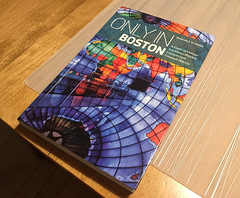From time to time, I do review travel guides, and as you can read from my review of Only in Edinburg, I’ve become quite a fan of the Only In Guides by Duncan J. D. Smith, primarily since he isn’t trying to provide a general purpose travel guide geared to the basics of how to use the bus, where to stay, and which museums to visit, but instead focuses on the unique and hidden attractions of a city. This makes it a particularly good travel guide if you find yourself visiting a city that you already know well (for example, I got his London guide after a solid decade of touring about London myself, and still found a lot of good recommendations). So, with that in mind, I was pleased that Duncan recently published a new guide, Only in Boston.
Yes, I bought a travel guide for a city that only 2.5 hours away and that I’ve visited probably a hundred times. And while it does have a few of the “classic” Boston area tourist attractions like Old Ironsides (number 3), the Bunker Hill monument (number 4), the Paul Revere Monument (number 14), Mother Goose’s burial plot (number 32), or the Prudential observation deck (number 79), or the Maparium (number 82), it also eschews some of the more common advice, with nary a mention of the Duck tours, and the Freedom Trail is only mentioned in passing. Like his other guides, this isn’t a full standalone guide or a replacement for doing a Google or Wikitravel search, but instead focuses on the sorts of gems that, even if you lived in Boston, you’ve likely not experienced.
Some of the particular items mentioned by Duncan J.D. Smith that I thought were particularly good gems included remnants of the old Charlestown Navy Yard (number 2), a particularly good walking tour of the old Shawmut Peninsula before large-scale earth-moving literally reshaped what we now know as Boston (number 8), the old Ether Dome operating theater (number 22), a good survey of the various buildings and relics of the Puritan era still remaining (number 31), and a discussion of why some of the streets are so crooked (number 38). It’s also got a good selection of memorial, including one to Radio Operators (number 11), the 54th African American Regiment of Glory fame (number 29), and the skull and memorial plaque for Phineas Gage, the famous survivor of having a iron rod driven through his skull (89).
There are also quite a few architectural delights of the sort you literally can walk by without noticing, like the home designed by Tiffany (the Ayer Mansion, number 80), the ornate doors of the Salada Tea company (number 68), and reused grand staircases (Exchange Place, item 37).
Throughout, the guide is well researched, and most attractions are accompanied by good photographs as well. Further more, the attractions are arranged in a reasonable order for a walking tour (Boston is, in fact, quite compact and walkable).
So, if you’re considering a trip to Boston, especially if you’ve already been to Boston and seen all of the usual sights, it’s time to consider picking up Only in Boston for some insights on what you may have missed.
(Disclaimer: Like several of his other guides, I did receive a review copy of Only in Boston from the author in thanks for providing photography and travel advice to him. I still find the books indispensable).


